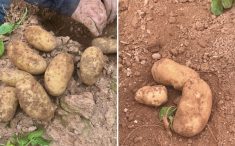Soil phosphorus levels are critically low in more and more fields. These fields may no longer provide enough phosphorus for crops to reach their yield potential, which means the solution to yield stagnation — on some fields, at least — could be plain old boring phosphate.
Canola takes up around 1.5 pounds of phosphate per bushel of yield, and about one lb./bu. is removed with the harvested seed. A 40-bushel crop, for example, removes around 40 pounds of phosphate per acre. Yet, applied phosphate rates are often well below this crop removal rate.
Read Also

Will investments in defence benefit Canadian agriculture?
A bump in Canada’s NATO spending commitments could lead to infrastructure investments that would benefit rural areas
“If growers feel like they’ve hit a plateau on yield — they apply more and more nitrogen and see no yield improvement — the other macros should be the first place to check,” says CCC agronomy specialist Warren Ward. “The first products to investigate should be phosphate and sulphur — especially if they are not being applied at recommended replacement rates, if soil testing repeatedly shows low levels, or if the crop shows symptoms of a deficiency.”
Only after checking phosphate and sulphur and not detecting any issues would a grower move on to potassium and micros, Ward says.
A grower’s reluctance to spend more on phosphate makes sense based on past experience. To some extent, phosphate removal can be naturally replenished from soil reserves in less soluble mineral forms or via release from soil organic forms. That’s why past work, as stated in the Canola Encyclopedia, concluded: “Canola shows a yield response to phosphate fertilizer no more than half the time.”
But as soil phosphate sinks into the “low” range, Alberta Agriculture research shows that the return on investment for following recommended rates can be very high. In fact, it says 90 to 95 per cent of the time growers will see a 5.0 bu./ac. yield boost — or more — from applying the soil-test recommended rate on black, thin black or grey wooded soils that have baseline soil phosphorus levels below 20 parts per million (40 lbs./ac.) based on the Kelowna soil test method.
An Agriculture and Agri-Food Canada study on phosphorus fertilizer for canola from 2010 to 2012 found when soil test levels are lower than 10 ppm, applying 40 lbs./ac. of phosphate provided a yield response every time, compared to no phosphate.
Jeff Schoenau, soil scientist at the University of Saskatchewan, adds that the yield response can be significant even when visual crop inspection doesn’t reveal an obvious problem. He calls phosphate deficiency the “hidden hunger” because, visually, the symptoms are often non-specific, making phosphorus deficiency in canola very difficult to identify.
Hidden hunger can result in stunted, unthrifty plants with lower seed set. “But unless you have something to compare it to, it can be difficult to pick out,” Schoenau says, “even when significant yield loss is occurring.”
1. What risk factors increase the chance of phosphate deficiency?
High yields, a rotation that includes high phosphate-removing crops, and phosphate rates that lag crop removal are the three big factors increasing the risk of phosphate deficiency.
Canola is a high-phosphate-using crop, yet safe seed-placed rates of phosphate are only about half of the removal rate. “By doing the right thing and keeping seed-placed phosphate levels in the safe range, growers are not matching phosphate rates with crop removal,” Ward says.
Even cereal crops, while they don’t remove as much phosphate per bushel, can remove as much per acre given their higher yield potential.
Also noteworthy is the effect of soil temperature on uptake. In cool early-season soils, roots develop more slowly and soil phosphorus availability is reduced. Canola will often respond to a maintenance application of phosphorus in cool soils, even when a soil test is moderately high for phosphorus.
2. How does a grower identify truly phosphate-deficient soil?
A soil test of the top six inches is “pretty reliable,” Schoenau says.
Soil-test extractable phosphorus of 10 pounds of P per acre (or five ppm) or less based on Olsen or modified Kelowna methods is a critically low level, Schoenau says. “If growers are not in a soil-testing and -monitoring system, they could end up with soils that are really quite low,” he says.
Tissue analysis can be a useful secondary test. Many soil-test labs offer tissue analysis. Check with them to get sampling and submission procedures. If the tissue test shows deficiency, a rescue application of phosphate will not help the immediate crop, but this will justify higher phosphate rates in following years.
Soil quality and field fertilizer management history are two other key indicators. Fields more likely to be deficient have a long history with more phosphate being removed than replaced through crop nutrition practices. Fields with low organic matter, that are tilled excessively or that have lost soil to erosion (i.e. leaving a thin A horizon) are also more likely to have low phosphate levels.
On the other hand, fields with high organic matter will have higher phosphate reserves, and fields with pH in the neutral 6.0 to 7.5 range will have increased phosphate availability.
3. Under what circumstances will matching phosphate rates with crop removal provide a return on investment?
Doubling phosphate rates from 20 lbs./ac. to 40 lbs./ac. will increase costs per acre by $13. This is based on $720 for a tonne of 11-52-0. This investment is more likely to provide a return in the year of application in fields where phosphate levels are considered deficient.
“Past research has shown little economic benefit from increasing phosphate from starter rates up to replacement rates,” Ward says, “but that may be changing on fields that now have low baseline levels of phosphate.”

John Heard, crop nutrition specialist with Manitoba Agriculture, Food and Rural Development, says replacement rates may not provide a return on investment in the year of application, but growers could expect to capitalize on the extra phosphorus over the long term.
Heard gives a house maintenance analogy. “I have a rental home and in the short term, I’m better off economically by ignoring the old shingles and drafty windows. But I know that if I don’t perform regular maintenance and take care of these big-ticket items a little each year, I’m going to be stuck with a deteriorated house with very little value and a huge payment to bring it back,” he says. Soil phosphate maintenance is like house maintenance.
“By maintaining soil phosphate in a medium-high range of 15-20 ppm soil-test phosphorus (30-40 lbs./ac.) growers will have more flexibility to perhaps cut phosphate rates in years when pencilling out a profit is more challenging,” Heard says. “But if soil phosphorus is 10 ppm or less (<20 lbs./ac.), growers will not have the flexibility to apply only starter rates because yield potential and profits are often sacrificed.”
Like the house analogy, one’s approach to soil phosphate often changes based on how long you expect to keep the land and whether you own or rent. (see Table 1 below)
4. How do growers rescue phosphate-deficient soil?
Building up phosphate levels is easier than building nitrogen levels because phosphate is not subject to leaching or volatilization losses, Schoenau says.
With this benefit, canola growers who don’t want to increase seed-placed rates could increase phosphate rates applied to cereals and count on this to be an overall benefit to all crops in rotation. However, even though safe seed-placed rates are higher for cereals, this would still not be enough to match removal for all crops. To match removal, some phosphate will have to go into the separate band with nitrogen and the other nutrients.
“It’s a pretty simple fix,” Ward says. “A soil test can identify any potential shortages, and extra phosphate fertilizer to match crop removal should prevent soil quality and yield from getting worse.”
How to diagnose nutrient deficiency
Visual assessment of nutrient deficiency symptoms is not good enough for an accurate diagnosis because symptoms can have many causes.
Purpling is one example. Purpling is often considered a telltale sign of phosphorus deficiency, but purpling can be a response to many types of stress. The plant is not producing chlorophyll in those areas, so the underlying purple pigment comes through.
Proper diagnosis of nutrient deficiency should use most of the following tools:
- Soil Test. Are any obvious shortages evident? other soil test parameters such as texture, pH and electrical conductivity may also provide clues in the diagnosis. Ask your lab what test it uses. Soil test P calibration work in Alberta has been with the Modified Kelowna method. Saskatchewan and Manitoba used the Olsen method for soil test P calibration. The Bray method, which some labs outside the Prairie region use, has not been calibrated for soils in Western Canada.
- Fertilizer history. Over the past five years, what rates and source products have been applied on that field? Include crop yields and consider whether rates have been adequate to match removal.
- Tissue test. A tissue test may show that the plant is deficient in phosphorus. if the tissue test shows deficiency, a rescue application of phosphate will not help the immediate crop, but this will help determine future phosphate rates.
- Herbicide history. Is there any chance of carry-over from products applied one or two years ago. Symptoms that look like fertilizer deficiency could be from herbicide carry- over damage to roots, which can restrict their ability to take up phosphorus. in dry conditions or very wet conditions, herbicides can take longer than expected to break down to safe recropping levels for canola.
- Environment. Cold, wet, hot and dry can all stress canola plants, creating symptoms that may look like nutrient deficiencies. If neighbours have similar symptoms, the cause is probably environmental – frost, excess moisture, etc.
- Field history. Recently broken forage land that has received little or no phosphorus fertilizer and has had large hay crops removed over the years is likely to be depleted. Canola seeded into a field that was in long-term alfalfa, for example, is one case where you may see severe crop stunting and delayed maturity as a result of phosphorus deficiency.
Jay Whetter is communications manager with the Canola Council of Canada. Listen to this podcast to hear more about phosphate fertilizer decisions. John Heard has also put together an excellent new phosphate management document, posted at the bottom of the article “Are we mining soil phosphorus?” at canolawatch.org.
This article was originally published as “Phosphorous Ph-inancials” in the April 2015 issue of Country Guide
















